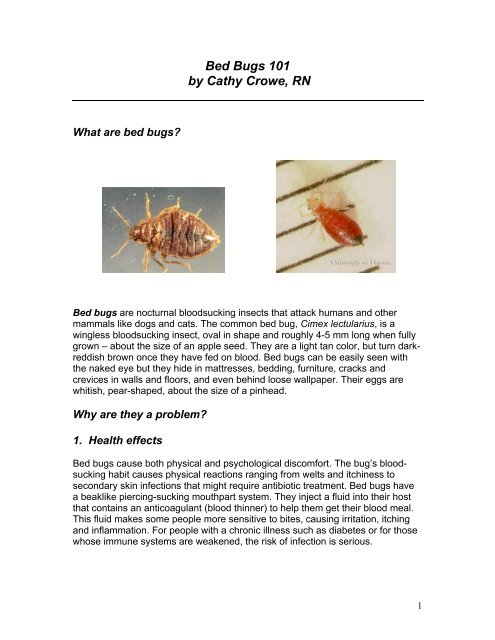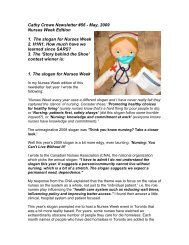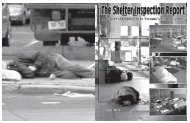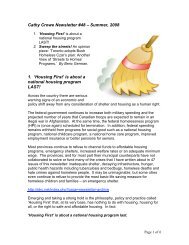Bed Bugs 101 by Cathy Crowe, RN
Bed Bugs 101 by Cathy Crowe, RN
Bed Bugs 101 by Cathy Crowe, RN
- No tags were found...
Create successful ePaper yourself
Turn your PDF publications into a flip-book with our unique Google optimized e-Paper software.
To date, there is no evidence that bed bugs spread other disease (hepatitis B,hepatitis C or HIV); although some argue that there is the possibility of aninfection spread.The physical discomfort and the social stigma that accompany bed buginfestations can lead to sleeplessness, anxiety, worry and stress for thoseinfested.For the elderly, people with disabilities and those with pre-existing physical ormental health conditions, bed bugs pose an additional health challenge.2. The cost<strong>Bed</strong> bugs are very difficult to eliminate and require a combination of chemicaland non-chemical approaches. This is known as ‘Integrated Pest Management’– a combination of repeated pesticide spraying, preparation of your home <strong>by</strong>moving furniture away from walls, intense vacuuming and laundry, steamcleaning,and in some cases the replacement of damaged mattresses, boxsprings and bedding. This takes time and money.For the most part, authorities such as public health professionals do not considerbed bugs a ‘health hazard’ or a public health concern because they might nottransmit disease. Instead, they consider bed bugs a ‘nuisance’ and a pest controlproblem. This disregard <strong>by</strong> officials is in part responsible for why city wide publiceducation and prevention strategies are not yet on the public agenda – let alonefunded – strategies that would have certainly minimized the growth of thisproblem.For recipients of social assistance there might be some help available to covercosts like mattresses, if items have to be replaced.<strong>Bed</strong> bug historyDo you remember this nursery rhyme?Night, night, sleep tight, don’t let the bed bugs bite!This rhyme that many of us recite in jest makes light of an old problem.<strong>Bed</strong> bugs were a common problem in homes prior to World War II. For the last40 years, they have been rarely seen outside of cramped living quarters. Thereduction in the incidence of bed bug infestations is thought to be related toimproved sanitation, widespread use of pesticides and intolerance towardsindoor pests.2
Often thought of as a disease of the poor, bed bugs can thrive in cleanenvironments and are not necessarily a reflection on cleanliness or personalhygiene.<strong>Bed</strong> bugs have made a comeback globally. In Canada, reports of bed bugs <strong>by</strong>pest control companies began in 2001 in Toronto. By 2003, Toronto shelters,hostels and social housing buildings reported dozens of infestations. By 2006there were reports of bedbugs in communities from Vancouver to Winnipeg andHalifax. A recent Ontario Non-profit Housing Association survey reported thatmore than 50% of buildings in mega cities have had a bed bug problem.Theories of why bed bugs made such a strong comeback include: the decreaseduse of insecticides such as DDT, the development of bed bug resistance topesticides, increased global travel, increased urban population density, and thediminished quality, availability and upkeep of housing in congregate livingsituations.In North America, bed bugs have been reported in hotels, motels, emergencyshelters, hospitals, student residences, rooming houses, social housing, co-opsand condos, as well as community centres, movie theatres, cruise ships, taxisand public transit. These are places with high rates of occupancy or turnover,and the bed bugs are being brought home!How are they spread?<strong>Bed</strong> bugs do not jump or fly so they either crawl or ‘hitch hike’ from place toplace on a wide range of articles including clothing, luggage, furniture, knapsacksand purses. They can stow away in boxes that are being moved, shipped ordelivered. They can arrive in second-hand furniture, household items or clothing– for example from items bought at flea markets or at swaps. <strong>Bed</strong> bugs areknown to crawl up to 20 feet at any one time and they can travel along pipes andelectrical wires. Once established in a home they can travel from room to room orunit to unit.How do they multiply?<strong>Bed</strong> bugs breed all year. They usually feed at night. The female needs a bloodmeal before laying eggs and can lay between 200 and 500 eggs in her lifetime,which can be over a year. Eggs are deposited in batches of 10-50 and hatch inabout 10 days, taking about two months to mature into adults. <strong>Bed</strong> bugs cansurvive up to a year without a human feed.Where do they hide?<strong>Bed</strong> bugs feed off of humans and animals, usually at night and spend the dayhidden. They hide and lay eggs in cracks and crevices. Their flattened shape lets3
them squeeze into narrow places in bed frames, headboards, in bedsidefurniture, behind baseboards, beneath decorator pillows or behind wall hangingsand draperies, under buttons on mattresses and box springs, behind pictures andswitch plates, in clock radios, phones, or in a book <strong>by</strong> the side of the bed, etc.How to Prevent <strong>Bed</strong> <strong>Bugs</strong>Prevention is smarter and cheaper!Don’t bring them home!• Think twice before you bring second hand furniture, sofas, beds,mattresses, bedding or clothing or appliances into your home.• Don’t bring in furniture from the street.• Carefully inspect for bed bugs and their eggs when buying used furnitureor clothing at garage sales, second-hand stores, rummage sales or swaptables.• Upholstered furniture and mattresses should be vacuumed and/orsteamed before using.• Be careful where you place your coat, knapsack, purse or briefcase whenyou are in a place that many people useDon’t let someone deliver them to your home!• When shopping for a new mattress, sofa or other furniture ask if thedelivery truck also takes away people’s old mattresses, etc. There havebeen reported cases of people ordering new items, only to have their newpurchase infested in the delivery truck.• If you order your groceries or other items online, make sure the companyis not using cardboard boxes, reused from other deliveries. Insist theymove to plastic delivery boxes.Household tips• Vacuum carpets, bedroom furniture and upholstered furniture on a regularbasis.• Reduce clutter, especially boxes and piles of things in your bedroom. Thiswill reduce hiding places for bedbugs and make it easier for treatment.• Caulk cracks and crevices in the building exterior and also repair orscreen openings to exclude birds, bats, and rodents that can serve asalternate hosts for bed bugs.• Caulk and fill holes that may be present around your baseboards.• If you are in the market for a new bed, consider a bed frame with metallegs and headboard which make it harder for bed bugs to climb.4
• Move your bed an inch or two away from walls and keep blankets andsheets off the floor.• If you have a wooden bed frame, the following are suggestions: apply aone-inch band of petroleum jelly (eg. Vaseline) around each wooden leg;place each leg of the bed in a clean, polished metal can; wrap each leg inmetal tape; wrap double-sided tape around the bed legs; use carpet tapeunder the bed legs, place an insect glue trap under each bed let. Thesemeasures can prevent bed bugs from crawling up.• <strong>Bed</strong> bugs have a hard time climbing up bed frames, especially if the legsare wiped with a cloth to keep them shiny. If in the market for a new bedconsider a metal frame.• Use a mattress cover. Sealing the mattress and box spring in a fitted vinylcover minimizes the places where bed bugs can hide.When you travel• Examine the bed for tell tale signs of bed bugs: speckles of dried bloodexcrement that can be found on the sheets or mattress. Examine bedheadboards, wall paper and/or moldings around headboards.• In the hotel room use the metal framed suitcase rack that is supplied foryour suitcase.• Keep suitcases, bags and clothing away from your bed and other furniture,both in the hotel room and when you first come home from a trip. Carefullyinspect your suitcase upon return, vacuum and scrub it with a stiff brush.Laundry and common areas• Washing and drying clothes is important – especially the dry cycle.• Heat and steam can kill them! Your building should make sure it hasenough dryers and you may wish to order a professional steamer (withtemperatures that can reach 70 Celsius).• Be careful where you place your clothes in laundry rooms so as not to pickup bed bugs that may have fallen off someone else’s laundry.• Do not place clothing donation boxes in multi-use places like laundry ormeeting rooms. Instead, encourage people to wash, label and donateclothing in a different manner.Other building issues• Consider tile or linoleum versus carpet in common areas.• Consider a special fund to assist elderly, disabled, chemically sensitiveand other tenants/members who need external assistance for preventionor treatment measures.• Contract with a reliable Integrated Pest Management Company that canprovide treatment and offer other solutions for your building.5
Ontario Non-Profit Housing Associationwww.onpha.on.ca (enter bed bug in the search function)HEALTH Canada pamphletwww.pmra-arla.gc.ca/english/pdf/pnotes/bed_bugs-e.pdf7







